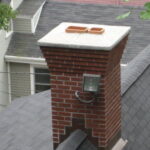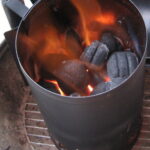They don’t make brick like they used to. That’s why if you have an old home with a brick surface of any kind whether it is a chimney or a whole home, your going to want to take good care of it. With time and weather, brick tends to lose its luster. Especially the mortar. Old mortar turns to dust with the years and crumbles and loosens the old brick. Pretty soon you’ve got a structural nightmare. You can re-point old an old brick wall yourself with a little sweat and cash. In this article I’ll show you how to re-point that old brick easily and cheaply.
Re-pointing brick is basically simple. It’s just a matter of removing the old mortar and replacing it with fresh mortar and striking it. You will need a few tools before you begin. You will need several cold chisels. A cape point cold chisel has a small pointed end for small area. You also need a plugging cold chisel. This chisel has a long flat for removing large sections in a tight space. You also need mortar tools. A tuck pointer and pointed trowel are necessary for re-pointing brick. A tuck pointer is a small flat and long trowel used for pressing mortar in between brick or block. The last tool you will need is a brick jointer. This is a small curved bar used to create a rounded edge when you strike the mortars outer surface. It creates a water resistant barrier in between the brick much better than a simple flat mortar surface could do.
Begin by breaking up the old mortar with the plugging chisel. Follow with the cape chisel to remove any stubborn pieces left behind. Don’t strike the chisel very hard, you may damage the brick. Instead use light taps with the hammer, similar to a wood pecker. Remove roughly ½ inch depth of mortar from between the bricks. Don’t do more than a square yard at a time before adding new mortar and letting it dry.
Brush away any debris or dust with a hand broom or use a shop vac. Once it is clean squirt the gaps down with a garden hose. Don’t over fill the gaps with water, just enough to keep the bricks moist. Mix the mortar in a small bucket or wheelbarrow. Scrape some mud up with your trowel and use the pointer trowel to press the mortar into the grooves between the bricks. Seat the mortar in between the bricks and press it in firmly. Add enough mortar until it is flush with the bricks surface. Work on the vertical joints first, and then fill the horizontal ones last. Keep all the excess mortar off the bricks as much as possible. Once you’re finished filling all the joints with mortar you can begin to strike the joints.
Striking joints means that you finish the rough surface in a v-shape or u-shape. The brick jointer you buy will have a v point on one end and a u point on the other. It’s up to you to decide which type of striking you prefer. Gently pull the brick jointer in one continuous motion. Strike all the vertical joints first, and then strike the horizontal joints last. Press firm enough to create the strike but not too hard so you remove the bond between the mortar and brick.
Clean any mortar from the face of the brick with a brush. Wait 24 to 48 hours for the mortar to dry and before you begin re-pointing any other area. Your brick should easily last another 50 years or more before it needs to be re-pointed again.



